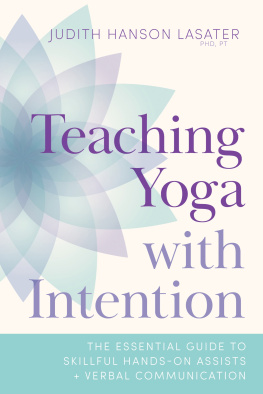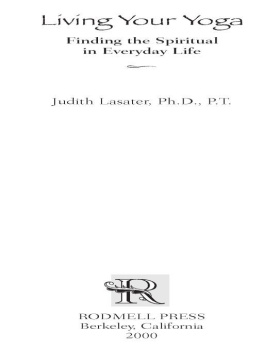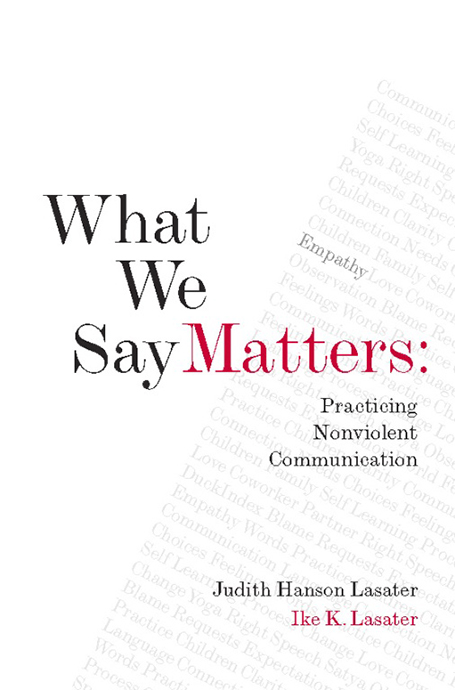Praise for What We Say Matters
What We Say Matters shows how speech can be a spiritual practice. A language of the heart has the power to create a world of connection, peace, and compassion in our own lives and in the whole human family. I am excited and inspired by how Judith and Ike present the NVC principles from the context of yoga philosophy and Buddhism in a way that is simple, clear, and practical, yet filled with depth and wisdom. I highly and enthusiastically recommend this book.
John Kinyon, trainer and mediator, The Center for Nonviolent Communication
As a longtime student of NVC (thanks to Judith and Ike), I am grateful for the clarity and wisdom of the material presented in What We Say Matters. I was inspired and encouraged by their personal stories and am excited to experiment with the practical suggestions and exercises. When I imagine the people who will read and use this book, I feel hopeful that we can all contribute to creating a more peaceful world.
Marcia Miller, co-owner of Yoga on High, Columbus, OH
When I read Judith and Ikes book, I feel happy, as though I have friends who speak to me and for me (rather than at me or down to me) and who will coach and counsel me through the intricacies of communicating more clearly and carefully, heart to heart, so that we may flower in each others presence. Thank you for this offering, a treasure that helps me to unfold inside.
Edward Brown, Zen teacher, author of The Tassajara Bread Book and The Complete Tassajara Cookbook
This book reminds me of conversations around the dinner table at Judith and Ikes house, exploring ways to deepen our consciousness and more fully live this one precious life. Now everyone is invited to be at that table.
Kit Miller, Director/Celebrator, Bay Area Nonviolent Communication
BY JUDITH HANSON LASATER
Published by Shambhala
Relax and Renew
Living Your Yoga
30 Essential Yoga Poses
Yoga for Pregnancy
Yoga Abs
A Year of Living Your Yoga
Yogabody
BY JUDITH HANSON LASATER AND IKE K. LASATER
Published by Shambhala
What We Say Matters
BY IKE K. LASATER
Published by PuddleDancer Press
Words That Work in Business
For our children and their loved ones
Table of Contents
A new idea is first condemned as ridiculous, and then dismissed as trivial, until finally it becomes what everybody knows.
WILLIAM BLAKE
Acknowledgments
WE WISH TO THANK the people who inspired us, taught us, and supported us as we wrote this book. Marshall Rosenberg, Ph.D., was the catalyst who helped us to see how satya and right speech could be lived, as we observed his practice and teaching of Nonviolent Communication. Our three children and our daughter-in-law have all given us great reason to become more aware of speech and how we could use it to create connection and clarity in our relationships. Finally, we wish to acknowledge all of our teachers, including B.K.S. Iyengar and Charlotte Joko Beck. To all of these people, we are humbly grateful.
Judith wishes to thank her yoga students and her friend and Zen teacher, Linda Cutts Weintrab, for their constancy. Ike would like to thank his teachers and colleagues on the road to incorporating the skills and understanding of Nonviolent Communication into his day-to-day life. In particular, he wants to thank John Kinyon for his support and companionship in the adventure of learning to mediate using NVC and learning how to offer trainings for others to do the same. We both thank Julie Stiles for her keen eye, sensitive review, and helpful editing in the writing stages of this book, and special appreciation for her collaboration with Ike in the creation of chapter 9.
We also thank our publishers, Donald Moyer and Linda Cogozzo, for their vision and for their practical help as this book took shape.
Introduction:
Why We Wrote This Book
Speech is a mirror of the soul: as a man speaks, so is he.
PUBLILIUS SYRUS
THATS NOT A FEELING, my husband Ike stated, gazing at me across the kitchen with a mixture of excitement and smugness. My look back at him was less than pleased. He had just returned from a seminar with Marshall Rosenberg on Nonviolent Communication (NVC), and he was telling me that my words did not describe feelings according to what he had learned. Unfortunately I was unable to hear his excitement or appreciate his insight, because I was too busy reacting negatively to him telling me how to talk.
When we tell this story at the NVC seminars that we teach together, we offer it as a perfect example of how not to practice the principles we share in this book. But the difficulty we had with each other was nothing compared with what happened as we began to use this technique with our three teenagers. We laugh now, but it was a painful period, as first Ike and then I began to change something we thought we already knew how to do: communicate.
Speech is the most human of activities. Babies begin making sounds from birth to communicate their needs, and a childs first word is a cause for celebration. Speech allows for the functioning of society on all levels. It would seem that nothing could be more natural than the use of speech to express our needs and to respond to the needs of others.
But belying its simple appearance, speech is actually created out of a complex interplay of factors. Our thoughts, beliefs, and perceptions powerfully shape our language to reflect our particular world. Without a clear awareness of our words, we can be dumbfounded daily by interactions that result in the opposite of what we intended. Research tells us that only a small percentage of what we say is actually heard, and even less of that is actually understood. Add to this the fact that different languages express actions and thoughts with different structures, and it is a wonder we understand each other at all.
Our interest in communication began much earlier than that incident in the kitchen in 1997. We both began to study yoga in 1970 and learned about the eight limbs, or ashtanga principles, of the yoga philosophy presented by Patanjali in the Yoga Sutra. The first principle for the practice of yoga is called yama, meaning restraint. There are five restraints, the first and most important of which is ahimsa, or nonviolence. Another yama is satya, or truth. The practitioner is admonished to speak the truth or, more accurately, to restrain from speech that is not true.
Ike and I both found that this ancient advice to speak the truth raised many questions. Whose truth? Dont we all experience reality differently? In the book Life Strategies, Phillip McGraw states, There is no reality, only perception. Ike and I found that while we agreed with truth as a value, we were not as easily able to understand it as a practice, as something we did with each utterance.









